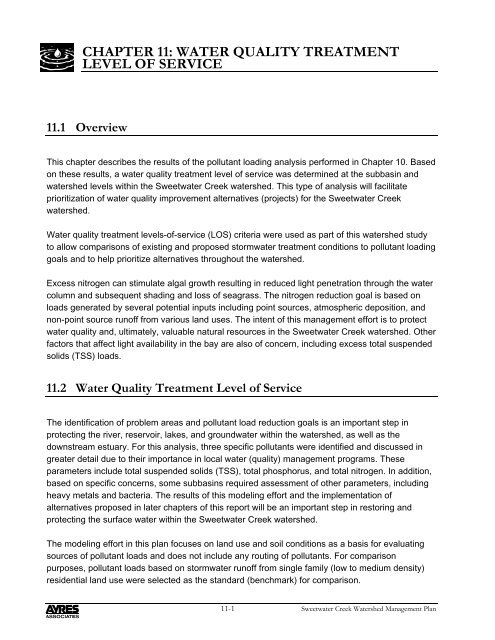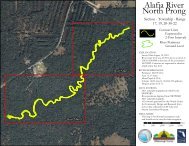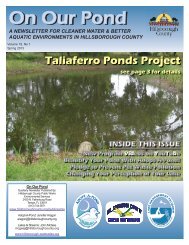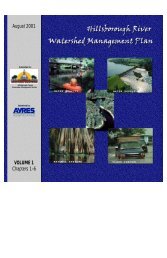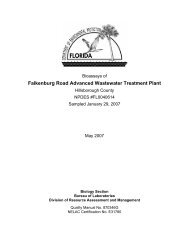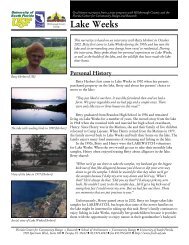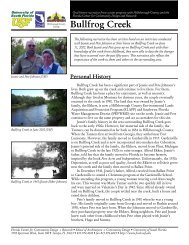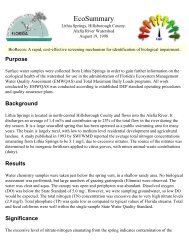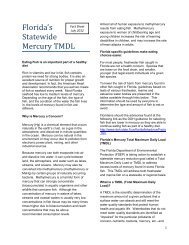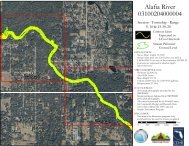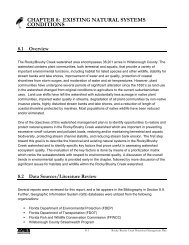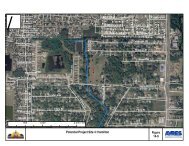Sweetwater Creek Watershed Mgmt. Plan 2007 Update--Part 2
Sweetwater Creek Watershed Mgmt. Plan 2007 Update--Part 2
Sweetwater Creek Watershed Mgmt. Plan 2007 Update--Part 2
You also want an ePaper? Increase the reach of your titles
YUMPU automatically turns print PDFs into web optimized ePapers that Google loves.
CHAPTER 11: WATER QUALITY TREATMENT<br />
LEVEL OF SERVICE<br />
11.1 Overview<br />
This chapter describes the results of the pollutant loading analysis performed in Chapter 10. Based<br />
on these results, a water quality treatment level of service was determined at the subbasin and<br />
watershed levels within the <strong>Sweetwater</strong> <strong>Creek</strong> watershed. This type of analysis will facilitate<br />
prioritization of water quality improvement alternatives (projects) for the <strong>Sweetwater</strong> <strong>Creek</strong><br />
watershed.<br />
Water quality treatment levels-of-service (LOS) criteria were used as part of this watershed study<br />
to allow comparisons of existing and proposed stormwater treatment conditions to pollutant loading<br />
goals and to help prioritize alternatives throughout the watershed.<br />
Excess nitrogen can stimulate algal growth resulting in reduced light penetration through the water<br />
column and subsequent shading and loss of seagrass. The nitrogen reduction goal is based on<br />
loads generated by several potential inputs including point sources, atmospheric deposition, and<br />
non-point source runoff from various land uses. The intent of this management effort is to protect<br />
water quality and, ultimately, valuable natural resources in the <strong>Sweetwater</strong> <strong>Creek</strong> watershed. Other<br />
factors that affect light availability in the bay are also of concern, including excess total suspended<br />
solids (TSS) loads.<br />
11.2 Water Quality Treatment Level of Service<br />
The identification of problem areas and pollutant load reduction goals is an important step in<br />
protecting the river, reservoir, lakes, and groundwater within the watershed, as well as the<br />
downstream estuary. For this analysis, three specific pollutants were identified and discussed in<br />
greater detail due to their importance in local water (quality) management programs. These<br />
parameters include total suspended solids (TSS), total phosphorus, and total nitrogen. In addition,<br />
based on specific concerns, some subbasins required assessment of other parameters, including<br />
heavy metals and bacteria. The results of this modeling effort and the implementation of<br />
alternatives proposed in later chapters of this report will be an important step in restoring and<br />
protecting the surface water within the <strong>Sweetwater</strong> <strong>Creek</strong> watershed.<br />
The modeling effort in this plan focuses on land use and soil conditions as a basis for evaluating<br />
sources of pollutant loads and does not include any routing of pollutants. For comparison<br />
purposes, pollutant loads based on stormwater runoff from single family (low to medium density)<br />
residential land use were selected as the standard (benchmark) for comparison.<br />
11-1 <strong>Sweetwater</strong> <strong>Creek</strong> <strong>Watershed</strong> Management <strong>Plan</strong>


